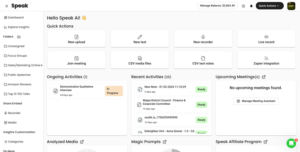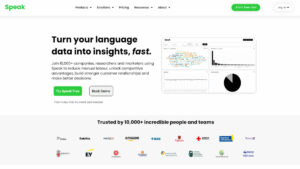
What's New In Speak - April 2024
Interested in What's New In Speak February 2024? Check out this post for all the new updates available for you in Speak today!
Focus groups are an important tool used by marketers, qualitative researchers, customer experience managers, market researchers, product researchers, SEO specialists, business analysts, data scientists, and academic researchers to gain insights into customer behaviour.
But what is the ideal size and number of people for successful focus groups? This guide from the Speak Ai team will cover the key factors to consider when deciding on the size and number of people for successful focus groups.
Focus groups are a type of qualitative research method used to collect data and gain insights into customer attitudes and behaviour. Focus groups are typically used to gain insights into customer needs, wants, and motivations.
Focus groups are usually composed of eight to twelve people and are led by a moderator. The moderator uses a structured approach to lead the conversation, asking questions and guiding the discussion.
Focus groups provide a range of benefits, including the ability to collect rich, qualitative data from a wide range of participants. Focus groups allow for the exploration of customer attitudes, beliefs, and motivations, as well as for the collection of candid feedback.
Focus groups also allow for the exploration of customer behaviour in a more natural setting, as the moderator is able to observe body language and other non-verbal cues.
When deciding on the ideal size and number of people for successful focus groups, there are several factors to consider. These include the purpose of the focus group, the target audience, the resources available, and the objectives of the study.
The purpose of the focus group should be taken into account when deciding on the ideal size and number of people. If the focus group is intended to provide insights into customer attitudes, beliefs, and motivations, then a larger group of participants may be preferable. On the other hand, if the focus group is intended to explore customer behaviour in a more natural setting, then a smaller group of participants may be more suitable.
The target audience should also be taken into account when deciding on the ideal size and number of people for successful focus groups. If the focus group is intended to target a specific demographic or consumer segment, then a smaller group of participants may be preferable. On the other hand, if the focus group is intended to target a broader range of customers, then a larger group of participants may be more suitable.
The resources available should also be taken into account when deciding on the ideal size and number of people for successful focus groups. Smaller focus groups may be more suitable for studies with limited resources, as they do not require as much time or as many resources to administer.
On the other hand, larger focus groups may be more suitable for studies with more resources available, as they can provide a greater number of insights and a broader range of perspectives.
The objectives of the study should also be taken into account when deciding on the ideal size and number of people for successful focus groups. If the focus group is intended to provide insights into customer attitudes, beliefs, and motivations, then a larger group of participants may be preferable.
However, if the focus group is intended to explore customer behaviour in a more natural setting, then a smaller group of participants may be more suitable.
So, what is the answer? We've alluded that it is between 8 to 10 subjects plus a facilitator. Any less may not be enough, and if there are more than 12 people often feel they need to share the time with others in the room and may not give you the full responses you are looking for.
The Office of Institutional Research and Assessment shares helpful hints for conducting a focus group that is worthwhile reviewing.
The ideal size and number of people for successful focus groups depend on a number of factors, including the purpose of the focus group, the target audience, the resources available, and the objectives of the study. Smaller focus groups may be more suitable for studies with limited resources, while larger focus groups may be more suitable for studies with more resources available. Ultimately, the ideal size and number of people for successful focus groups will depend on the specific objectives of the study.
Get a 7-day fully-featured trial.


Interested in What's New In Speak February 2024? Check out this post for all the new updates available for you in Speak today!

Interested in What's New In Speak February 2024? Check out this post for all the new updates available for you in Speak today!

Interested in What's New In Speak February 2024? Check out this post for all the new updates available for you in Speak today!

Thank you for continuing to be part of this journey - it means the world to us. Below is a summary of our 2023 at

Interested in The Best Executive Research Firms? Check out the dedicated article the Speak Ai team put together on The Best Executive Research Firms to learn more.

Interested in The Best Consumer Research Firms? Check out the dedicated article the Speak Ai team put together on The Best Consumer Research Firms to learn more.

Powered by Speak Ai Inc. Made in Canada with
Use Speak's powerful AI to transcribe, analyze, automate and produce incredible insights for you and your team.